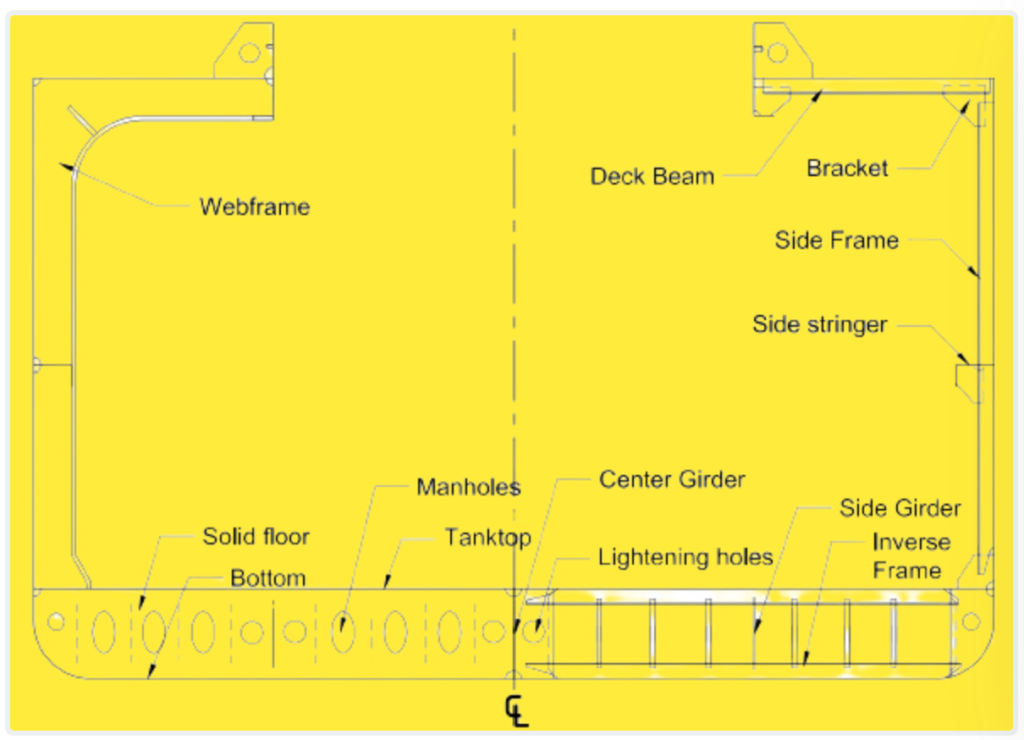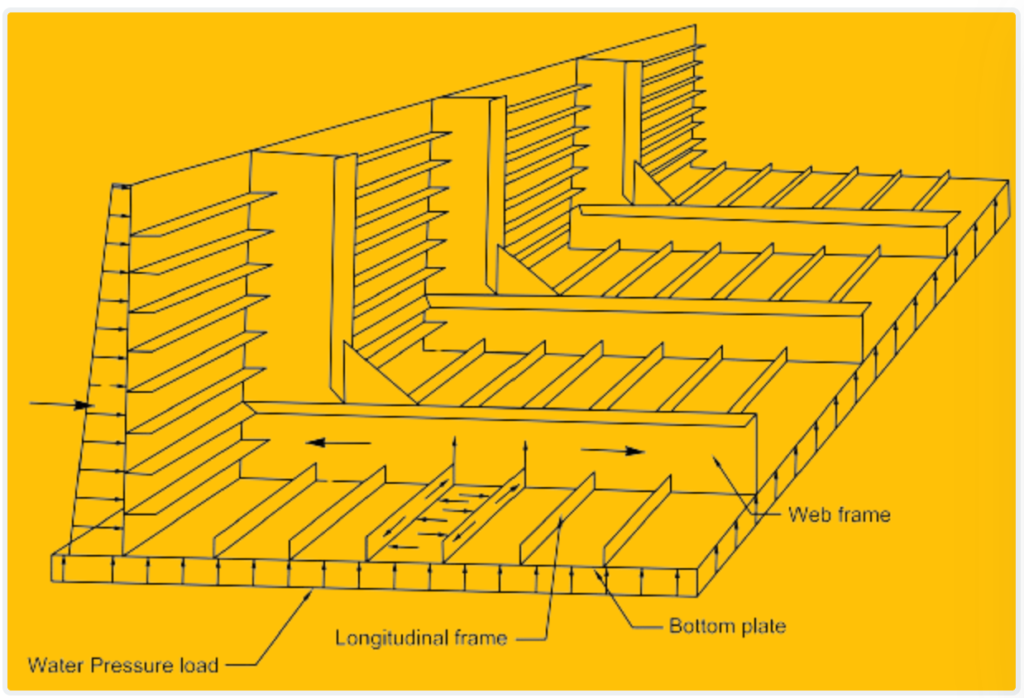The ship structure refers to the framework or skeleton of the vessel that provides it with stability, strength, and integrity to withstand various forces and conditions encountered during its operation at sea. It includes all the components and elements that make up the physical framework of the ship, including the hull, decks, bulkheads, transverse and longitudinal members, superstructure, and other supporting structures.
Structural design for ships is a critical phase in the shipbuilding process, transforming conceptual data into tangible structural components that will form the vessel’s framework. It involves translating the operational profile, main dimensions, and hull characteristics determined in the initial design phase into detailed structural plans that will guide fabrication in the shipyard.
During structural design, various factors are taken into account to ensure the ship’s structural integrity, strength, and safety under different operating conditions and environmental loads. This includes analyzing the anticipated loads and stresses the ship will experience during its service life, such as wave action, cargo weight, and operational maneuvers, and designing the ship structure to withstand these forces without failure or deformation.
The ship structure design framework
The ship structural design framework involves understanding and managing three main aspects: loads, responses, and strength.
- Loads: These are the forces that act on the ship’s structure, whether it’s as a whole or on individual components. These forces can come from various sources such as waves, cargo weight, and operational maneuvers. Loads cause stresses and deformation in the structure.
- Responses: Responses refer to the deformations and stresses that occur in the structure as a result of external loads. When a load is applied to the structure, it causes it to bend, twist, or deform in some way. Understanding these responses helps designers predict how the structure will behave under different conditions.
- Strength: Strength is the measure of the structure’s ability to withstand the applied loads without failing or deforming beyond acceptable limits. It’s essential to ensure that the ship structure remains intact and functional under various operating conditions and environmental forces.
By considering these factors, structural designers can create robust and reliable ship structures that meet safety standards and performance requirements. They rely on experience, guidelines from classification societies, and engineering principles to design structural arrangements and determine the appropriate scantlings (dimensions) for each component.

Hierarchy levels and initial considerations
In ship structural analysis, there are three hierarchy levels and initial considerations:
- Primary Analysis: This level involves analyzing the smallest units of a ship’s structure, which are panels bounded by stiffeners. These panels experience normal and in-plane loads, leading to bending, buckling, and shear deformations. Primary analysis focuses on understanding the behavior of these individual panels under various loading conditions.
- Secondary Analysis: At this level, larger flat or curved surfaces of plating with sets of stiffeners, known as grillages, are analyzed. Grillages are supported at their edges by bulkheads and deck edges, which provide additional stiffness. Similar to panels, grillages are subjected to normal and in-plane loads, resulting in bending, buckling, and shear loads. Secondary analysis considers the behavior of grillages as integrated structural elements.
- Tertiary Analysis: The highest level of analysis involves considering the entire ship structure as a hollow box girder, which can be treated as a beam. This holistic approach considers the interaction between bulkheads, grillages, and decks to understand the overall structural response of the ship. Tertiary analysis evaluates the combined effects of loads on the entire ship structure.
By categorizing the analysis into primary, secondary, and tertiary levels, structural engineers can systematically assess and address the structural integrity and performance of the ship under different loading conditions. This hierarchical approach ensures a comprehensive understanding of the ship’s structural behavior from individual components to the entire ship structure.
Structural Design Framing
Structural design commences by establishing the frame spacing and defining key structural boundaries such as the double bottom height, twin deck height, and longitudinal bulkhead location. The midship section is then designed, incorporating parameters such as beam, depth, draft, deadrise, and bilge radius. These initial design choices may be adjusted based on the specific ship type and its operational requirements.
Two primary framing systems are commonly used: the transverse framing system and the longitudinal framing system. In the transverse system, secondary members are oriented in the transverse direction of the ship, while in the longitudinal system, stiffeners are aligned longitudinally.
Additionally, openings are incorporated into the structures, including decks, tanks, and solid floors. These openings facilitate access for maintenance, piping, and wiring, while also reducing overall structural weight and cost. By carefully considering these design elements, shipbuilders can create structures that meet both functional requirements and efficiency goals.


Load Carrying Mechanism
Understanding how loads are carried within a ship structure is essential before conducting any structural analysis. This process outlines how external and internal loads are transferred to the internal structural elements. External loads typically include forces from waves and still water, while internal loads may arise from liquids in tanks, cargo, machinery vibration, and other dynamic sources.
The load-carrying mechanism begins with the plates, which directly bear the external pressure from water and potentially internal pressure from liquids in tanks. These plates are supported by longitudinal members, transferring the load as line loads along their length. These longitudinal members, or stiffeners, are in turn supported by side web frames at specific intervals, resulting in point loads on the web frames at the connection points. The web frames are further supported by the side structures, continuing the load-carrying mechanism throughout the ship’s structure.

This sequence illustrates how external pressures are transmitted through the longitudinal frames, causing point loads on the web frames, and ultimately supported by the side structures. Understanding this load-carrying mechanism is crucial for designing ship structures that can withstand various external and internal forces encountered during operation.